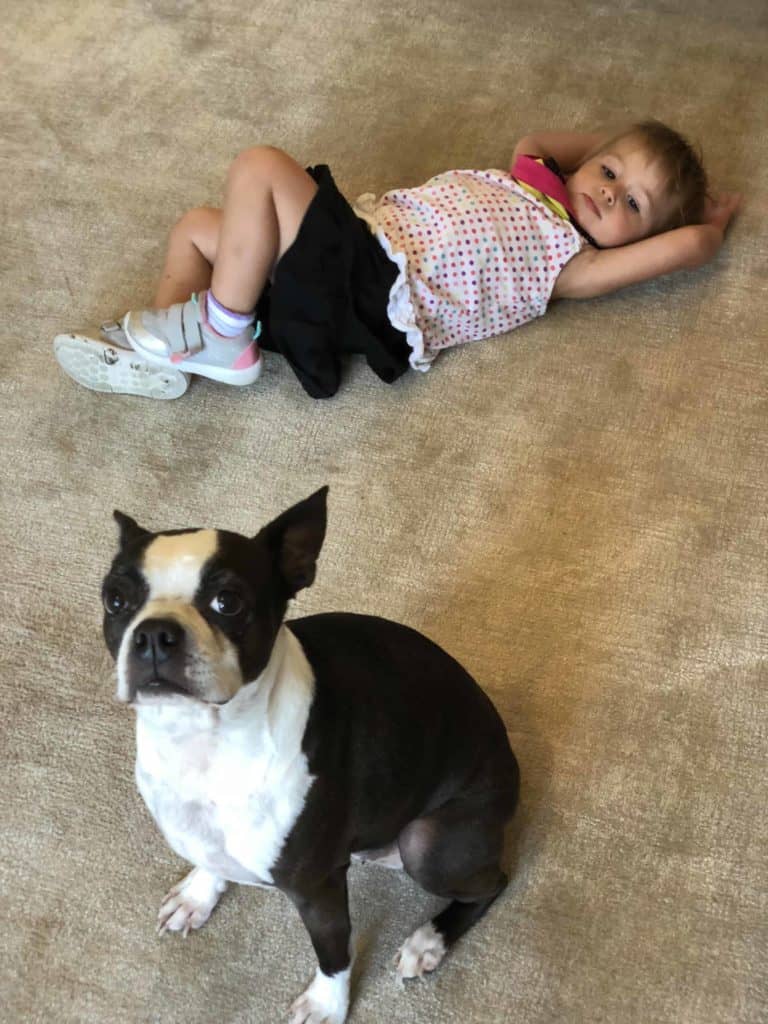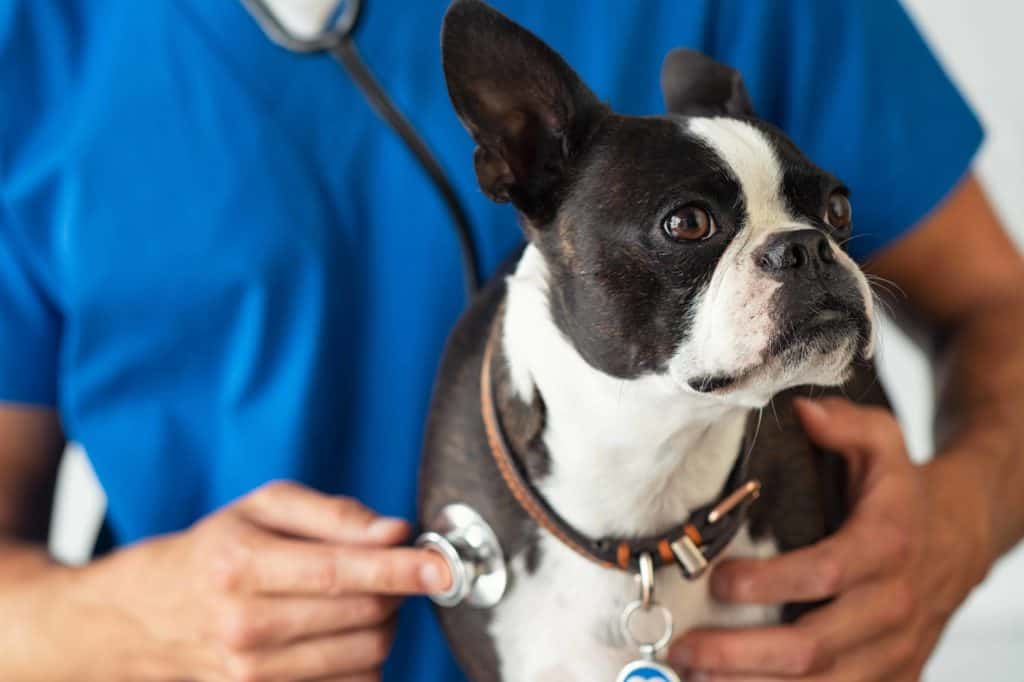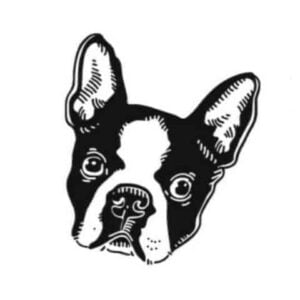You may have noticed reddish-brown tear stains beneath your Boston Terrier’s eyes and wondered if those unsightly stains are harmful. As well as what your treatment options are available.
Thankfully, tear stains will not affect your beloved Boston’s health. Yet it is essential to understand what tear stains are. Including what could be causing these stains before you commit to any at-home treatment plan.

I have seen tear stains in Bella come and go. Emily and I personally have never tried to do anything about the tear stains because, for Bella, it has been pretty mild. However, some Boston owners have said this is a significant issue for them. This is what I have found out in my research.
How to remove a Boston Terriers tear stains?
There is no quick cure for tear stains on your Boston Terrier. The best approach is daily cleaning to the tear-stained area keeping it dry and clean.
There are more options, but daily cleaning will be the best approach. Here is what I have found out about tear stains and what you can do to eliminate this problem.
Tear Stains Are Common
First, tear stains are prevalent in certain breeds, including Boston Terriers. These stains tend to be more noticeable on dogs with a lot of white fur on their faces. The stains may range in color from dark brown to a more reddish hue. Discharge or a crusty buildup may be present, but some dogs will clean their faces with their paws to prevent buildup. You may also notice an unpleasant odor coming from the affected area.
The rusty brown coloring you’ve noticed, and odor, are likely due to a yeast infection on the surface of the skin. Your Boston’s natural body warmth and the moist environment caused by constant tear production are ideal conditions for yeast growth.
Yeast occurs naturally on your dog’s skin, but overgrowth typically only occurs when her skin is exposed to excess moisture. A yeast infection usually does not bother the dog. However, some dogs may find the yeast irritating and try to rub their face with their paws, your furniture, or floors.
What Causes Tear Stains?
Excess tear production or the eye’s inability to drain tears properly is commonly referred to as epiphora. Although epiphora is a condition itself, it is often a symptom of underlying issues. The condition can be either acute or chronic, depending on what is causing it.
Often, it’s merely due to a malformed tear duct that simply can not keep up with tear production. There is generally no long-term adverse effect from abnormal tear ducts, and daily cleaning is the best treatment.
Potential Infections
Your veterinarian will likely want to check your Boston’s eyes for any possible infection that could be causing the eyes to water. Eye infections are relatively common and are relatively easy to treat if caught in the early stages. Epiphora is also a symptom of conjunctivitis, which is inflammation of the lining of the eye.
If you notice any:
- Redness around the eye.
- Swelling around the eye.
- Your dog seems to be rubbing or scratching at her eye.
If you notice the above symptoms, this may be an infection caused by her tear stains. These symptoms may also occur when the eye is exposed to irritants, such as smoke or dust.
Allergies
Allergies are another possible cause for your Boston’s excess tear production. Allergens may be found either in your Boston’s diet or in her environment. It is important to consider all possibilities when developing a treatment plan.
For some dogs, allergies may be seasonal, so you may only need to treat your pup’s allergies during the spring and summer seasons. If the reaction is due to an allergen present in your dog’s food, you may need to consider a diet with alternative proteins or even a prescription diet, if necessary.
Your veterinarian will be able to advise you on the best course of action to treat your dog’s allergies and hopefully reduce your dog’s excess tear production.
Entropion
Entropion is a condition in dogs where one or both eyelids are inverted. When the eyelid turns in, the eyelashes then rub against the eye, causing irritation. If not treated quickly, entropion can actually cause permanent damage to the eye, so it’s essential to seek treatment as soon as possible. Surgery is often required to return the eyelid to its natural position.
Short-Nosed Dogs
It’s not uncommon for brachycephalic (short-nosed) dogs, such as Boston Terriers, to have shallower than normal eye sockets. If your Boston’s eyes seem to bulge out slightly, she may have shallow eye sockets.
Dogs with this condition often have trouble closing their eyelids completely, which can cause them to become dry or irritated. This irritation may cause the eye to produce excess tears.
Check with your Vet

Before beginning any at-home treatment for tear stains, you should discuss the problem with your veterinarian to rule out any underlying medical conditions. Certain supplements may have a reaction with certain medications. It is best practice to be cautious and make sure your vet approves before you begin using any new wipes or supplements.
How to Get Rid of Tear Stains
If your veterinarian has found any problems in your dog’s eyes, such as infection or malformed eyelids, following the prescribed treatment plan should help reduce tear production and staining. Treatment may consist of oral medications, diet, lifestyle changes, or even surgery.
Unfortunately, there is no simple way to get rid of your Boston Terrier’s tear stains. If your veterinarian has not found any treatable medical condition behind the excess tear production, daily management is your best option. Wiping your pooch’s tear stains frequently with a soft cloth will help reduce the moisture on the skin and help prevent yeast overgrowth. You can also use a product designed to minimize staining, either topically or orally.
Find the Solution Right for your Pup!
As there is no miracle cure for tear stains, you may need to try a few products before determining what works best for you and your Boston. Your local pet store or favorite online retailer likely has a selection of topical products designed to reduce staining.
Some products may be packaged as pre-moistened wipes, while others will come in a bottle and need to be applied with a cotton ball. The frequency that you use the product will vary, so be sure the read the product’s instructions carefully.
Colloidal Silver
Some owners have found success in using colloidal silver to clean their dog’s faces. Colloidal silver is a natural product consisting of microscopic flakes of pure silver suspended in a liquid, usually demineralized water.
The colloidal silver is said to have antifungal and antibacterial properties. Because of the antifungal and antibacterial properties, this supplement can help prevent an overgrowth of bacteria on your Boston’s skin. Although it’s also safe to use near your dog’s eyes, you should still probably avoid getting any in her eyes if possible.
As of yet, there haven’t been any clinical studies to prove the effectiveness of colloidal silver. However, many owners have found success in using it to treat tear stains.
To get pricing and options on colloidal silver, check out Amazon for the latest, Colloidal Silver.
Oral Supplements
Several oral supplements claim to reduce tear staining by providing your dog with specific nutrients that may be lacking in her diet. Although a few owners may claim to see a difference in their dog’s tear stains, most people find oral supplements to be a waste of money.
Often, tear production is due to problems in the eye or the dog’s environment, so a change in diet is unlikely to have much effect. Oral supplements also tend to be quite expensive, so you may want to try a few topical solutions first.
Changes to Your Dog’s Drinking Water
If you prefer more natural treatments, you may want to try switching to filtered water. Some experts have suggested that filtered water can help prevent tear stains. Although this has not been proven, water quality does vary depending on where you live, so it may be worth a try.
Apple Cider Vinegar
It has also been suggested that adding a small amount of apple cider vinegar to your dog’s water can help. The reasoning behind this is that the vinegar increases the body’s pH level. This slight increase in the body’s acidity will create a hostile environment for the yeast growing on your dog’s skin.
For Boston Terriers, adding just a teaspoon or so of apple cider vinegar to your pup’s water bowl may make a difference in her tear stains. However, apple cider vinegar does have a rather strong flavor that some dogs may find unpleasant. You may need to start with smaller amounts or stick to other treatment options.
To get pricing and options on Apple Cider Vinegar, check out Amazon for the latest, Apple Cider Vinegar.
Avoid Harsh Chemicals
No matter what treatment plan you choose to follow, it’s important to avoid harsh chemicals or cleaning products. Using hydrogen peroxide, vinegar, or makeup remover around your Boston’s eyes is dangerous and could result in permanent damage to the eye.
As unsightly as tear stains may be, you must also avoid using dye or bleach to cover up the stains. Unfortunately, there is no quick fix for tear stains, so avoid any product that claims to remove stains in a short time. These products, whether they be oral or topical, may cause more damage than good.
If you have any doubts about a particular product, ask your veterinarian whether it’s safe to use on your precious pup.
Final Thoughts . . .
When it comes to tear stains, the phrase “an ounce of prevention is worth a pound of cure” comes to mind. Unless your dog has an underlying infection or medical condition, you’ll likely find yourself working to prevent further staining, rather than curing it. Daily cleaning will go a long way toward preventing yeast overgrowth. By keeping the area clean and dry, you’ll discourage both the reddish-brown staining and the unpleasant odor associated with yeast.
Have you found a trick on preventing tear stains? Please share by leaving a comment below.
Need More Grooming Tips? Check out my following articles:
- How To Trim Your Boston’s Nails
- How Often To Give Your Boston A Bath
- How To And What Type Of Brush Should You Use On A Boston
- How To Properly Clean A Boston’s Ears
- How To Brush Your Boston’s Teeth
References
- PetMD – Treating and Preventing Dog Tear Stains
- Leo’s Pet Care Veterinary – A Vets Guide To Tear Stains
